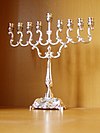Judas Maccabeus
| Judas Maccabeus | |
|---|---|
Promptuarii Iconum Insigniorum (1553) | |
| Leader of the Maccabees | |
| Tenure | 167–160 BCE |
| Predecessor | Mattathias |
| Successor | Jonathan Apphus |
| Died | April 160 BCE Elasa, Seleucid Empire |
| Burial | |
| Dynasty | Hasmonean |
| Father | Mattathias |
Judah Maccabee (or Judas Maccabaeus
The Jewish holiday of Hanukkah ("Dedication") commemorates the restoration of Jewish worship at the Second Temple in Jerusalem in 164 BC, after Judah Maccabee removed all of the statues depicting Greek gods and goddesses and purified it.
Life
Early life
Judah was the third son of
Origin of the name "The Hammer"
In the early days of the rebellion, Judah received the surname Maccabee. It is not known whether this surname should be understood in Greek, Hebrew or Aramaic. Several explanations have been put forward for this surname. One suggestion is that the name derives from the
According to Jewish folklore, the name Maccabee is an acronym of the verse Mi kamokha ba'elim Adonai, "Who among the gods is like you, O Adonai?", the Maccabean battle-cry to motivate troops. (Exodus 15:11). Some scholars maintain that the name is a shortened form of the Hebrew maqqab-Yahu (from naqab, "to mark, to designate"), meaning "the one designated by Yahweh."[4] Although originally the surname Maccabee was exclusive to Judah (his brothers had different surnames), at a later date it came to signify all the Hasmoneans who fought during the Maccabean revolt.[5]
Early victories

Mindful of the superiority of Seleucid forces during the first two years of the revolt, Judah's strategy was to avoid any engagement with their regular army, and to resort to
Shortly thereafter, Judah
The defeat at
After Jerusalem
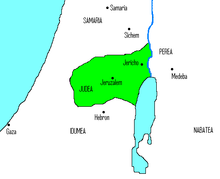
Upon hearing the news that the Jewish communities in
Judah then laid siege to the Seleucid garrison at the
Internal conflict
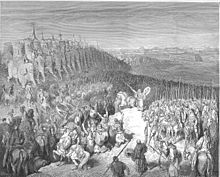
When war against the external enemy came to an end, an internal struggle broke out between the party led by Judah and the Hellenist party. The influence of the Hellenizers all but collapsed in the wake of the Seleucid defeat. The Hellenizing
Meanwhile, Demetrius I Soter, son of Seleucus IV Philopator and nephew of the late Antiochus IV Epiphanes, fled from Rome in defiance of the Roman Senate, arrived in Syria. Declaring himself the rightful king, he captured and killed Lysias and Antiochus Eupator, taking the throne. It was thus Demetrius to whom the delegation led by Alcimus, complained of the persecution of the Hellenist party in Judea. Demetrius granted Alcimus's request to be appointed High Priest under the protection of the king's army and sent to Judea an army led by Bacchides. The weaker Jewish army could not oppose the enemy and withdrew from Jerusalem, so Judah returned to wage guerrilla warfare. Soon after, it was necessary for the Seleucid Army to return to Antioch because of the turbulent political situation. Judah's forces returned to Jerusalem and the Seleucids dispatched another army, again led by Nicanor. In a battle near Adasa, on the 13th Adar 161 BCE, the Seleucid army was destroyed and Nicanor was killed. The annual "Day of Nicanor" was instituted to commemorate this victory.
Agreement with Rome and death
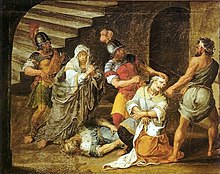
The
The agreement with Rome failed to have any effect on Demetrius' policy. On receipt of the news of Nicanor's defeat, he dispatched a new army, again commanded by Bacchides. This time the Seleucid forces of 20,000 men were numerically so superior that most of Judah's men left the field of battle and advised their leader to do likewise and to await a more favorable opportunity. However, Judah decided to stand his ground.
In the Battle of Elasa, Judah and those who remained faithful to him were killed. His body was taken by his brothers from the battlefield and buried in the family sepulchre at Modiin. The death of Judah Maccabee (d. 160 BCE) stirred the Jews to renewed resistance. After several additional years of war under the leadership of two of Mattathias' other sons (Jonathan and Simon), the Jews finally achieved independence and the liberty to worship freely.
In the arts
Pre-19th century
As a warrior hero and national liberator, Judah Maccabee has inspired many writers, and several artists and composers. In the Divine Comedy, Dante sees his spirit in the Heaven of Mars with the other "heroes of the true faith". In Shakespeare's Love's Labour's Lost, he is enacted along with the other Nine Worthies, but heckled for sharing a name with Judas Iscariot. Most significant works dedicated solely to him date from the 17th century onwards. William Houghton's Judas Maccabaeus, performed in about 1601 but now lost, is thought to have been the first drama on the theme; however, Judas Macabeo, an early comedia by crucial Spanish playwright Pedro Calderón de la Barca, is extant. Fernando Rodríguez-Gallego details its history in his critical edition: the play was performed in the 1620s in different versions and finally published as part of an anthology by Vera Tassis in 1637. Following on its heels is El Macabeo (Naples, 1638), a Castilian epic by the Portuguese Marrano Miguel de Silveyra. Two other 17th-century works are La chevalerie de Judas Macabé, by French poet Pierre Du Ries,[8] and the anonymous Neo-Latin work Judas Machabaeus (Rome, 1695). Handel wrote his Judas Maccabaeus oratorio (1746) on the subject.
19th century
There has been interest in Judah in every century. Giuda Macabeo, ossia la morte di Nicanore... (1839) is an Italian "
20th century
Several 20th-century Jewish authors have also written works devoted to Judah Maccabee and the Maccabean Revolt. Jacob Benjamin Katznelson (1855–1930) wrote the poem, "Alilot Gibbor ha-Yehudim Yehudah ha-Makkabi le-Veit ha-Hashmona'im" (1922); the Yiddish writer Moses Schulstein wrote the dramatic poem, "Yehudah ha-Makkabi" (in A Layter tsu der Zun, 1954); Jacob Fichman's "Yehudah ha-Makkabi" is one of the heroic tales included in Sippurim le-Mofet (1954). Amit Arad's historical novel "Lions of Judea – The miraculous story of the Maccabees" (2014). Many children's plays have also been written on the theme by various Jewish authors.
In addition, the American writer
During World War II the Swiss-German writer Karl Boxler published his novel Judas Makkabaeus; ein Kleinvolk kaempft um Glaube und Heimat (1943), the subtitle of which suggests that Swiss democrats then drew a parallel between their own national hero, William Tell, and the leader of the Maccabean revolt against foreign tyranny.
The modern play Playing Dreidel with Judah Maccabee by Edward Einhorn is about a contemporary boy who meets the historical figure.[9]
Visual arts
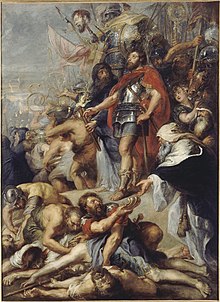
In the
Music
In music, almost all the compositions inspired by the Hasmonean rebellion revolve around Judah. In 1746, the composer
Tom Lehrer refers to Judas Maccabeus in his song "Hanukkah in Santa Monica".
Mirah refers to Judah Maccabee in her song "Jerusalem".
In "The Goldbergs Mixtape", a parody song is named "Judah Macabee".[citation needed]
See also
- Jewish leadership
- List of Hasmonean and Herodian rulers
- Nine Worthies
References
- Scroll of Antiochus, and where the name is rendered as מַקבֵּי.
- ^ 2 Maccabees 5:1–1
- ^ Virtually all that is known about Judah Maccabee is contained in the Books of the Maccabees and in the works of Josephus, largely dependent on this source.
- ^ New Catholic Encyclopedia, second edition, vol. 9, p. 9
- ^ "חשמונאים". 27 February 2018. Archived from the original on 1 December 2021. Retrieved 1 December 2021.
- ^ Galilee, however, does not seem to have been evacuated of its Jewish population, since two generations later, when John Hyrcanus conquered it, he found it largely inhabited by Jews.
- ^ Josephus Flavius Antiquities of the Jews Book 12 Chapter 8 paragraph 6.
- ^ Smeets, Jean-Robert; Ries, Pierre du; Belleperche, Gautier de; Belleperche), Gautier (de (1955). La Chevalerie de Judas Macabé (in French). Van Gorcum.
- ^ Sierra, Gabrielle. "Theater 61 Press Presents Playing Dreidel with Judah Maccabee".
Further reading
- Schalit, Abraham (1997). "Judah Maccabee". ISBN 965-07-0665-8
- Schäfer, Peter (2003). The History of the Jews in the Greco-Roman World. Routledge. ISBN 0-415-30585-3
External links
- The Hasmoneans on the web
- Judas Maccabeus on the Web (pictures and directory)
- Jewish Encyclopedia
- Catholic Encyclopedia
- Judah Maccabee
- "Under the Influence: Hellenism in Ancient Jewish Life" Archived 2012-02-29 at the Wayback Machine Biblical Archaeology Society
- Who Was Judah Maccabee? by Dr. Henry Abramson
- Lions of Judea, novel series by Amit Arad

